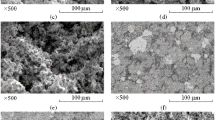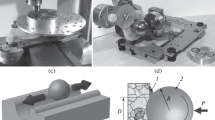Abstract
In these studies, one group of PCD materials has been prepared using diamond powder and 10 wt % of TiB2 and the second batch of the PCD material has been prepared using a mixture of diamond powder with 5 wt % of TiB2 and 2 wt % of Co. The materials have been sintered using a Bridgman-type high-pressure apparatus at 8.0 ± 0.2 GPa and a temperature of 2000 ± 50 °C. Thermogravimetric (TG) measurements and Differential Thermal Analysis (DTA) have been carried out for diamond micropowders, TiB2 bonding phase, and sintered composites. The coefficients of friction for diamond composites in a sliding contact with an Al2O3 ceramic ball have been determined from the room temperature up to 800°C. Material phase compositions were analyzed for initial samples and after wear tests, at the temperature of 800°C. Raman spectra of diamond composites with borides bonding phases, observed for the first-order zone center modes of diamond and graphite during heating up to 800°C in air have been presented. Thermal properties have been compared with the commercial diamond-cobalt PCD. It has been found that diamond with TiB2 and Co is the most resistant to the hardness changes at elevated temperatures and this material maintains the high hardness value up to 800°C but it has a high coefficient of friction.
Similar content being viewed by others
References
Milton, S., Metal Cutting Principles, 2nd ed., New York: Oxford University Press, 2005.
Field, J.E., Properties of Diamond, Academic Press, 1979, pp. 474–475.
Home, J.Y., Jones, L.E., and Cormack, A.N., The oxidation of diamond, in Proc. CARBON’ 01, Lexington, KY, July 14 2001, paper 6.2. Retrieved from: http://www.acs.omnibooksonline.com/data/papers/2001-6.2.pdf
Tankala, K., Debroy, T., and Alam, M., Oxidation of diamond films synthesized by hot filament assisted chemical vapor deposition, J. Mater. Res., 1990, vol. 5, pp. 2483–2489.
Strong, H.M. and Hanneman, R.E., Crystallization of diamond and graphite, J. Phys. Chem., 1967, vol. 46, p. 3668.
Fedortchouk, Y. and Canil, D., Diamond oxidation at atmospheric pressure: development of surface features and the effect of oxygen fugacity, Eur. J. Mineral, 2009, vol. 21, pp. 623–635.
Burnsa, R.C., Hansena, J.O., Spitsa, R.A., Sibandaa, M., Welbournb, C.M., and Welcha, D.L., Growth of high purity large synthetic diamond crystals, Diam. Relat. Mater., 1999, vol. 89, pp. 1433–1437.
Konstanty, J., Powder metallurgy diamond tools—A review of manufacturing routes. Progress in Powder Metallurgy, Part 2, Mater. Sci. Forum, 2007, vol. 534–536, pp. 1121–1124.
Szutkowska, M., Jaworska, L., Rozmus, M., and Krolicka, B., Diamond composite with titanium diboride bonding phase obtained by HP-HT technique, J. Aust. Ceram. Soc., 2012, vol. 48, pp. 141–143.
Baik, S. and Becher, P.F., Effect of oxygen contamination on densification of TiB2, J. Am. Ceram. Soc., 1987, vol. 70, pp. 527–330.
Jaworska, L., Szutkowska, M., Klimczyk, P., Sitarz, M., Bucko, M., Rutkowski, P., Figiel, P., and Lojewska, J., Oxidation, graphitization, and thermal resistance of PCD materials with the various bonding phases of up to 800°C, Int. J. Refract. Met. Hard Mater., 2014, vol. 45, pp. 109–116.
Zachariev, Z., New superhard ternary borides in composite materials, metal, ceramic and polymeric composites for various uses, in Cuppoletti, J., Ed., InTech, 2011, pp. 67–72. Retrieved from: http://www.intechopen.com/books/metal-ceramic-and-polymeric-composites-for-various-uses/new-superhard-ternary-borides-in-composite-materials.
Lavrenko, V.A., Podchernyaeva, I.A., Peikhua, K., Talash, V.N., and Smirnov, V.I., Effect of cladding diamond powder with a nickel-phosphorus alloy on its high-temperature oxidation, Powder Metal. Met. Ceram., 1996, vol. 35, no. 1–2, pp. 48–50.
Koh, Y.H., Lee, S.Y., and Kim, H.E., Oxidation behavior of titanium boride at elevated temperatures, J. Am. Ceram. Soc., 2001, vol. 84, pp. 239–241.
Nemanich, R.J., Glass, J.T., Lucovsky, G., and Shroder, K.E., Raman scattering characterization of carbon bonding in diamond, J. Vac. Sci. Technol. A, 1988, vol. 63, pp. 1783–87.
Author information
Authors and Affiliations
Corresponding author
Additional information
The text was submitted by the authors in English.
About this article
Cite this article
Jaworska, L., Klimczyk, P., Szutkowska, M. et al. Thermal resistance of PCD materials with borides bonding phase. J. Superhard Mater. 37, 155–165 (2015). https://doi.org/10.3103/S1063457615030028
Received:
Published:
Issue Date:
DOI: https://doi.org/10.3103/S1063457615030028




